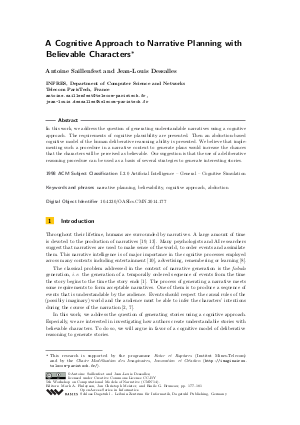A Cognitive Approach to Narrative Planning with Believable Characters
Authors Antoine Saillenfest, Jean-Louis Dessalles
-
Part of:
Volume:
2014 Workshop on Computational Models of Narrative (CMN 2014)
Part of: Series: Open Access Series in Informatics (OASIcs) - License:
 Creative Commons Attribution 3.0 Unported license
Creative Commons Attribution 3.0 Unported license
- Publication Date: 2014-08-08
File

PDF
OASIcs.CMN.2014.177.pdf
- Filesize: 346 kB
- 5 pages
Document Identifiers
Subject Classification
Keywords
- narrative planning
- believability
- cognitive approach
- abduction
Metrics
- Access Statistics
-
Total Accesses (updated on a weekly basis)
0Document
0Metadata
Abstract
In this work, we address the question of generating understandable narratives using a cognitive approach. The requirements of cognitive plausibility are presented. Then an abduction-based cognitive model of the human deliberative reasoning ability is presented. We believe that implementing such a procedure in a narrative context to generate plans would increase the chances that the characters will be perceived as believable. Our suggestion is that the use of a deliberative reasoning procedure can be used as a basis of several strategies to generate interesting stories.
Cite As Get BibTex
Antoine Saillenfest and Jean-Louis Dessalles. A Cognitive Approach to Narrative Planning with Believable Characters. In 2014 Workshop on Computational Models of Narrative. Open Access Series in Informatics (OASIcs), Volume 41, pp. 177-181, Schloss Dagstuhl – Leibniz-Zentrum für Informatik (2014)
https://doi.org/10.4230/OASIcs.CMN.2014.177
BibTex
@InProceedings{saillenfest_et_al:OASIcs.CMN.2014.177,
author = {Saillenfest, Antoine and Dessalles, Jean-Louis},
title = {{A Cognitive Approach to Narrative Planning with Believable Characters}},
booktitle = {2014 Workshop on Computational Models of Narrative},
pages = {177--181},
series = {Open Access Series in Informatics (OASIcs)},
ISBN = {978-3-939897-71-2},
ISSN = {2190-6807},
year = {2014},
volume = {41},
editor = {Finlayson, Mark A. and Meister, Jan Christoph and Bruneau, Emile G.},
publisher = {Schloss Dagstuhl -- Leibniz-Zentrum f{\"u}r Informatik},
address = {Dagstuhl, Germany},
URL = {https://drops.dagstuhl.de/entities/document/10.4230/OASIcs.CMN.2014.177},
URN = {urn:nbn:de:0030-drops-46556},
doi = {10.4230/OASIcs.CMN.2014.177},
annote = {Keywords: narrative planning, believability, cognitive approach, abduction}
}
Author Details
References
-
Mieke Bal. Narratology: Introduction to the theory of narrative. University of Toronto Press, 1997.

-
Joseph Bates. The role of emotion in believable agents. Communications of the ACM, 37(7):122-125, 1994.

-
Jean-Louis Dessalles. A computational model of argumentation in everyday conversation: A problem-centred approach. In Proceedings of the 2008 Conference on Computational Models of Argument (COMMA 2008), pages 128-133, Amsterdam, The Netherlands, The Netherlands, 2008. IOS Press.

-
Umberto Eco and Thomas A Sebeok. The sign of three: Dupin, holmes, peirce. In Umberto Eco and Thomas A Sebeok, editors, Advances in Semiotics. Indiana University Press, Indianpolis, 1988.

-
Lynd Forguson. Common sense. Cambridge Univ Press, 1989.

-
Pablo Gervàs. Computational approaches to storytelling and creativity. The AI magazine, 30(3):49-62, 2009.

-
A.C. Graesser, M. Singer, and T. Trabasso. Constructing inferences during narrative text comprehension. Psychological Review, 101(3):371-375, 1994.

-
Suzanne Hidi and K.A. Renninger. The four-phase model of interest development. Educational Psychologist, 41(2):111-127, 2006.

-
Jerry R. Hobbs, Mark E. Stickel, Douglas E. Appelt, and Paul Martin. Interpretation as abduction. Artificial Intelligence, 63(1-2):69 - 142, 1993.

-
Walter Kintsch. Learning from text, levels of comprehension, or: Why anyone would read a story anyway. Poetics, 9(1-3):87 - 98, 1980.

-
L. Magnani. Abduction, Reason, and Science. Kluwer Academic/Plenum Publishers, 2001.

-
Bertram F. Malle and Joshua Knobe. The folk concept of intentionality. Journal of Experimental Social Psychology, 33(2):101-121, 1997.

-
Neal R. Norrick. Conversational Narrative : Storytelling in everyday talk. John Benjamins Publishing Company, 2000.

-
Keith Oatley and Philip N Johnson-Laird. Towards a cognitive theory of emotions. Cognition and emotion, 1(1):29-50, 1987.

-
Mary Jo Rattermann, Lee Spector, Jordan Grafman, Harvey Levin, and Harriet Harward. Partial and total-order planning: evidence from normal and prefrontally damaged populations. Cognitive Science, 25(6):941-975, 2001.

-
Mark O. Riedl and R. Michael Young. An objective character believability evaluation procedure for multi-agent story generation systems. In Themis Panayiotopoulos, Jonathan Gratch, Ruth Aylett, Daniel Ballin, Patrick Olivier, and Thomas Rist, editors, Intelligent Virtual Agents, volume 3661 of Lecture Notes in Computer Science, pages 278-291. Springer Berlin Heidelberg, 2005.

-
Mark O. Riedl and R. Michael Young. Narrative planning: Balancing plot and character. Journal of Artificial Intelligence Research, 39(1):217-268, 2010.

-
Antoine Saillenfest and Jean-Louis Dessalles. Using unexpected simplicity to control moral judgments and interest in narratives. In Mark A. Finlayson, Bernhard Fisseni, Benedikt Löwe, and Jan Christoph Meister, editors, 2013 Workshop on Computational Models of Narrative, volume 32 of OpenAccess Series in Informatics (OASIcs), pages 214-227, Dagstuhl, Germany, 2013. Schloss Dagstuhl-Leibniz-Zentrum fuer Informatik.

-
Deborah Tannen. Conversational style: Analyzing talk among friends. Oxford University Press, 1984.

